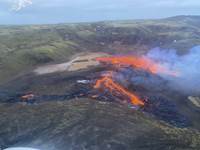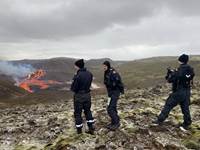A small volcanic eruption has started in Iceland
- No risk to Reykjavik, populated places and infrastructure
- No disturbance for international aviation
At approximately 20.45 last night lava began flowing from a rupture in the ground around Fagradalsfjall near the fishing town of Grindavík on the Reykjanes peninsula. The eruption is considered to be small and due to its location, there is no threat to any populated areas or critical infrastructure. A few roads in the vicinity of the eruption have been closed and people are advised to stay away from valleys and other places near the fissure where toxic gases can accumulate.
The eruption comes after more than two weeks of intense seismic activity that started with a 5.7 magnitude earthquake on 24 February. The eruption is a part of an ongoing geological event that was first noticed in January 2020 as a measurable rise in the land in the vicinity of the eruption.
Keflavik/Reykjavík International Airport was briefly closed last night while scientists assessed the situation and confirmed that air traffic was safe. All flights to Iceland have resumed as normal and international flight corridors are open.
The eruption was first seen on a web camera positioned close the mountain and was also confirmed on thermal satellite imagery. Icelandic Coast Guard helicopters flew over the area with scientists on board soon after the eruption started. They describe the eruption as very small with relatively insignificant lava production and it will most likely be short-lived. The last eruption in the Reykjanes Peninsula was recorded over 700 years ago, and eruptions in Mt Fagradalsfjall (Mount of Fair Valley) last happened around 6000 years ago.
"This type of eruption in a location like this does not cause worry in Iceland. We have been expecting the ongoing seismic activity to result in a volcanic event such as this. Due to the fortunate location of the fissure, the eruption presents a respite from ongoing seismic activities, which have been highly uncomfortable for the people living close to the event. We will continue to monitor the eruption and ensure the safety of the people living in the area," says Katrín Jakobsdóttir, Prime Minister of Iceland.
The response to any potential volcanic activity is led by the Department of Civil Protection and Emergency Management of the police in cooperation with the Icelandic Meteorological Office and University of Iceland.
The eruption is classified as a fissure eruption (often referred to as Icelandic-type) and does not usually result in large explosions or significant production of ash dispersed into the stratosphere. Scientists expect the eruption to last anywhere between a few days and a few weeks.



